Cancer and Cancer Health Disparities in Philadelphia

Community Brief
September 2020
What is cancer?
Cancer is a disease that occurs when cells in the body grow out of control and spread to other parts of the body. There are many types of cancer. Screening tests may help find some types of cancer before a person has symptoms. Many different treatments are now available for cancer. Early diagnosis and treatment can improve how people do after they are diagnosed with cancer.
How common is cancer in Philadelphia?
In 2016, 7,972 people in Philadelphia were newly diagnosed with cancer. This amounts to 478 new cases of cancer for every 100,000 Philadelphians (this number is called the incidence rate). Cancer is somewhat more common in men than in women: there were 528 new cases of cancer for every 100,000 men and 446 new cases of cancer for every 100,000 women in the city in 2016.1
Figure 1 shows the incidence rates of cancer in 2016 for the three most common types of cancer in men and women. Prostate cancer is the most common type of cancer in men, followed by lung cancer and colorectal cancer. Breast cancer, lung cancer, and colorectal cancer are the three most common types of cancer diagnosed in women.
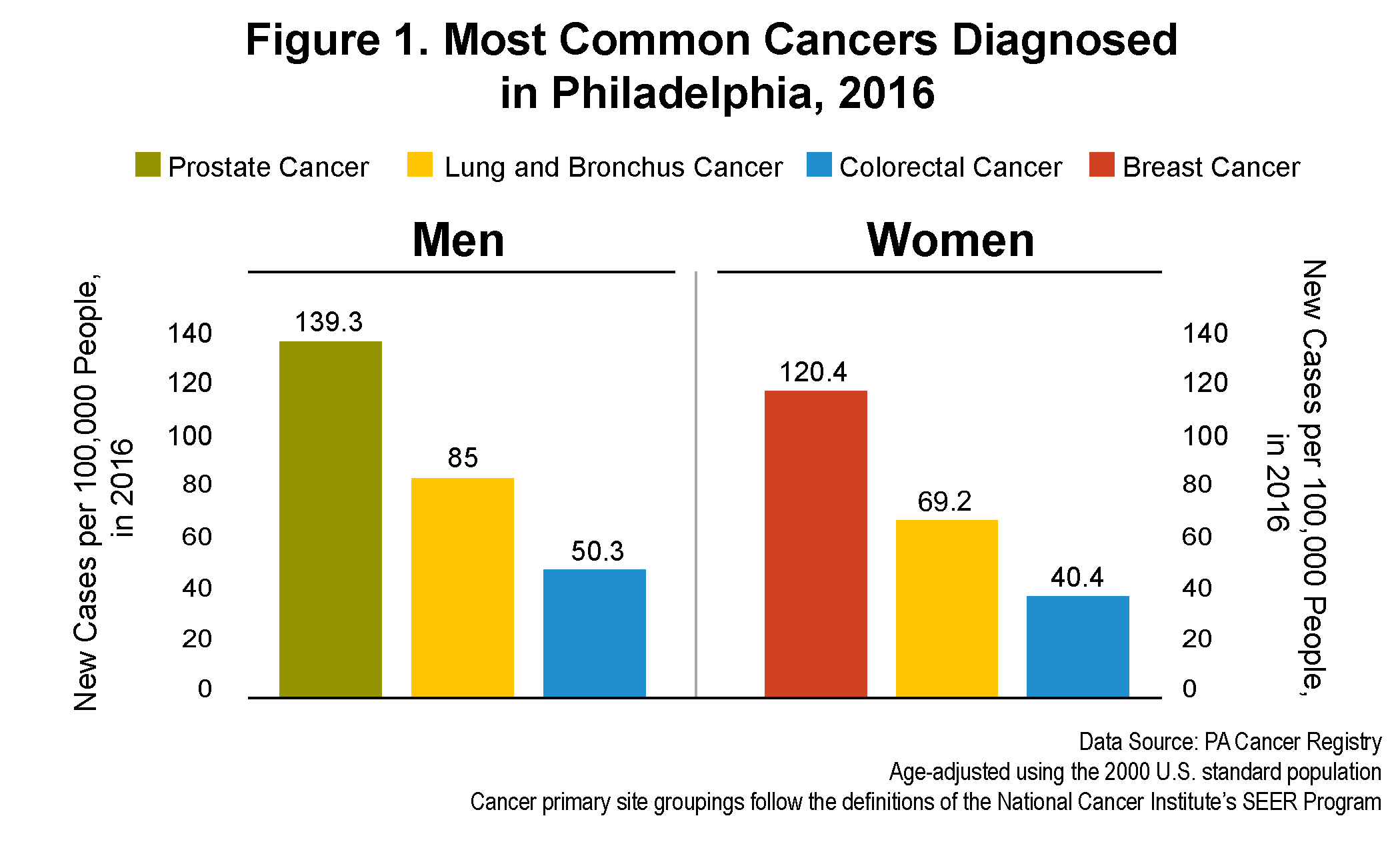
In 2016, there were 3,127 deaths due to cancer in Philadelphia. This amounts to 190 deaths for every 100,000 Philadelphians (this number is called the mortality rate).2 Figure 2 shows the mortality rates of cancer in 2016 for the three most common types of cancer deaths in men and women. Lung cancer is the leading cause of cancer death in both men and women although it is not the most common type of cancer diagnosed.
Some of the differences seen in cancer between men and women are because of biological differences. For example, breast cancer is much more common in women. Other differences result from known risk factors like tobacco use, which has been historically higher among men. However, increases in smoking by women over time have resulted in more lung cancer cases in women.3
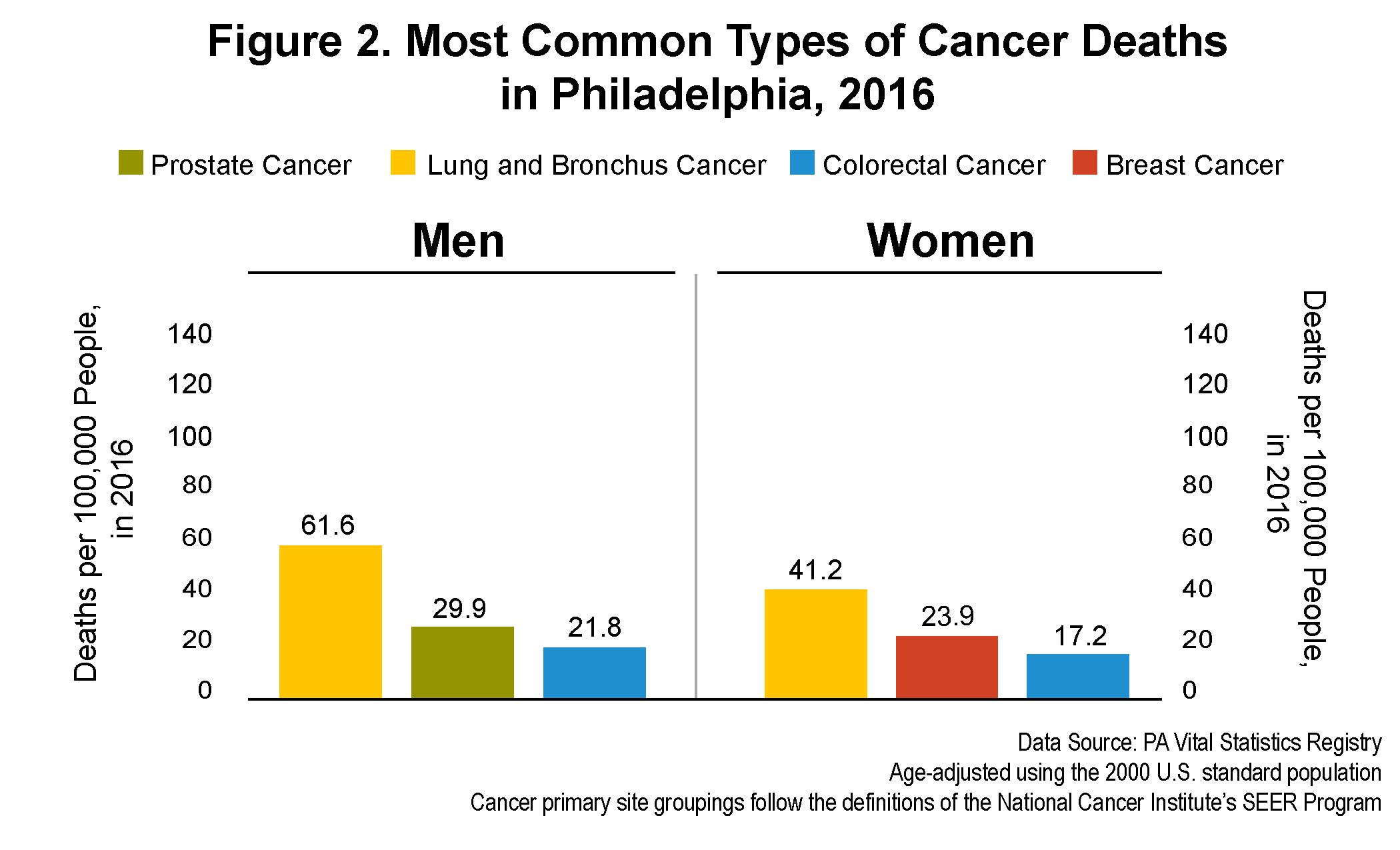
How does cancer vary by age?
People are more likely to get cancer as they get older. Although there are some cancers in children, the likelihood of being diagnosed with cancer increases with age. Figure 3 shows the incidence rates in Philadelphia from 2000 to 2016 of all cancers and the most common types of cancer for people of different ages.
Cancer can increase with age because of the biological consequences of getting older. It can also increase because exposure to risk factors for cancer, like number of years of smoking also increases as people get older.
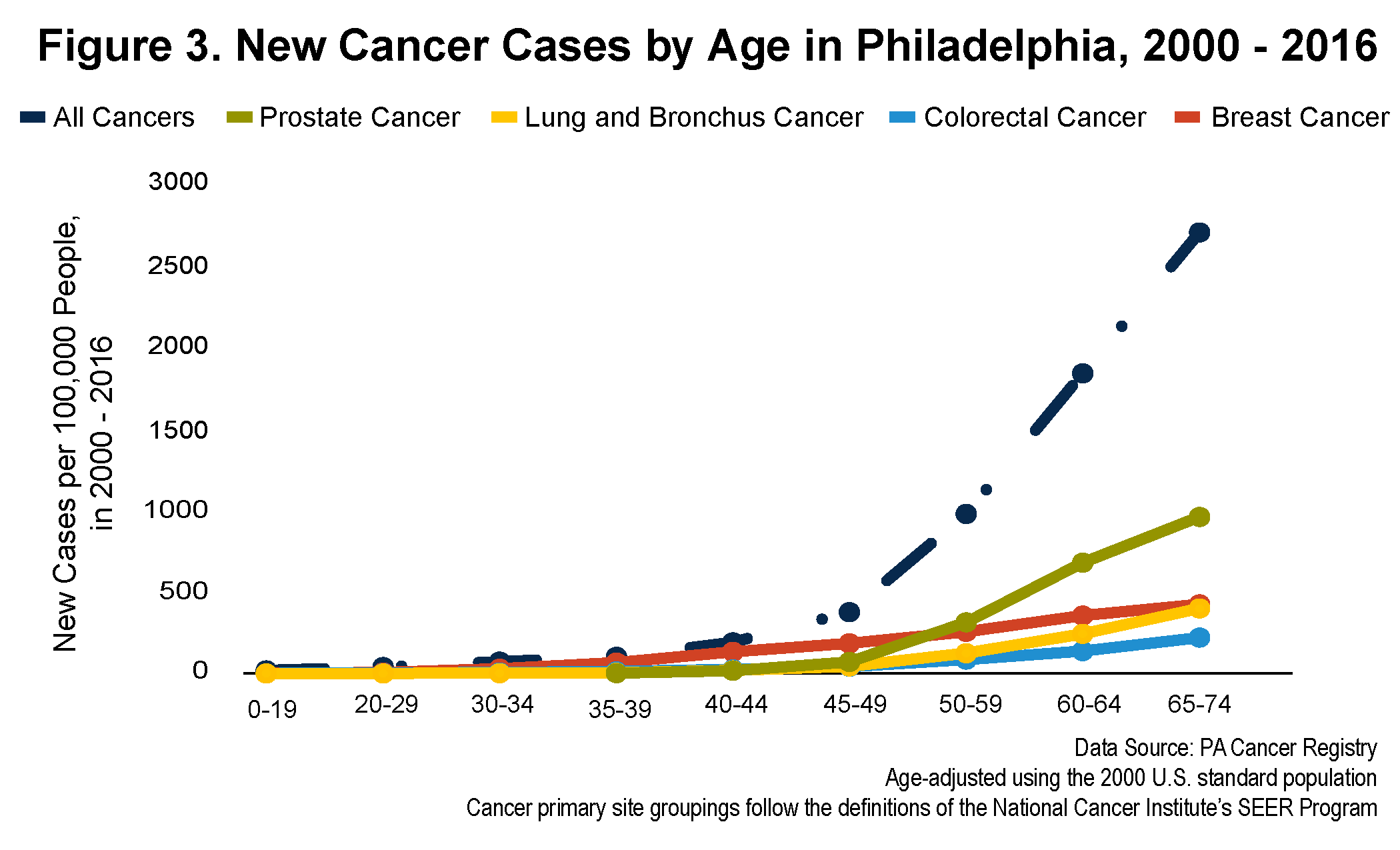
How does cancer vary by race?
As shown in Figure 4, the incidence rates of cancer in women are about the same in white and Black women, but lower among Hispanic women. Black men have more cases of prostate cancer compared to white and Hispanic men.
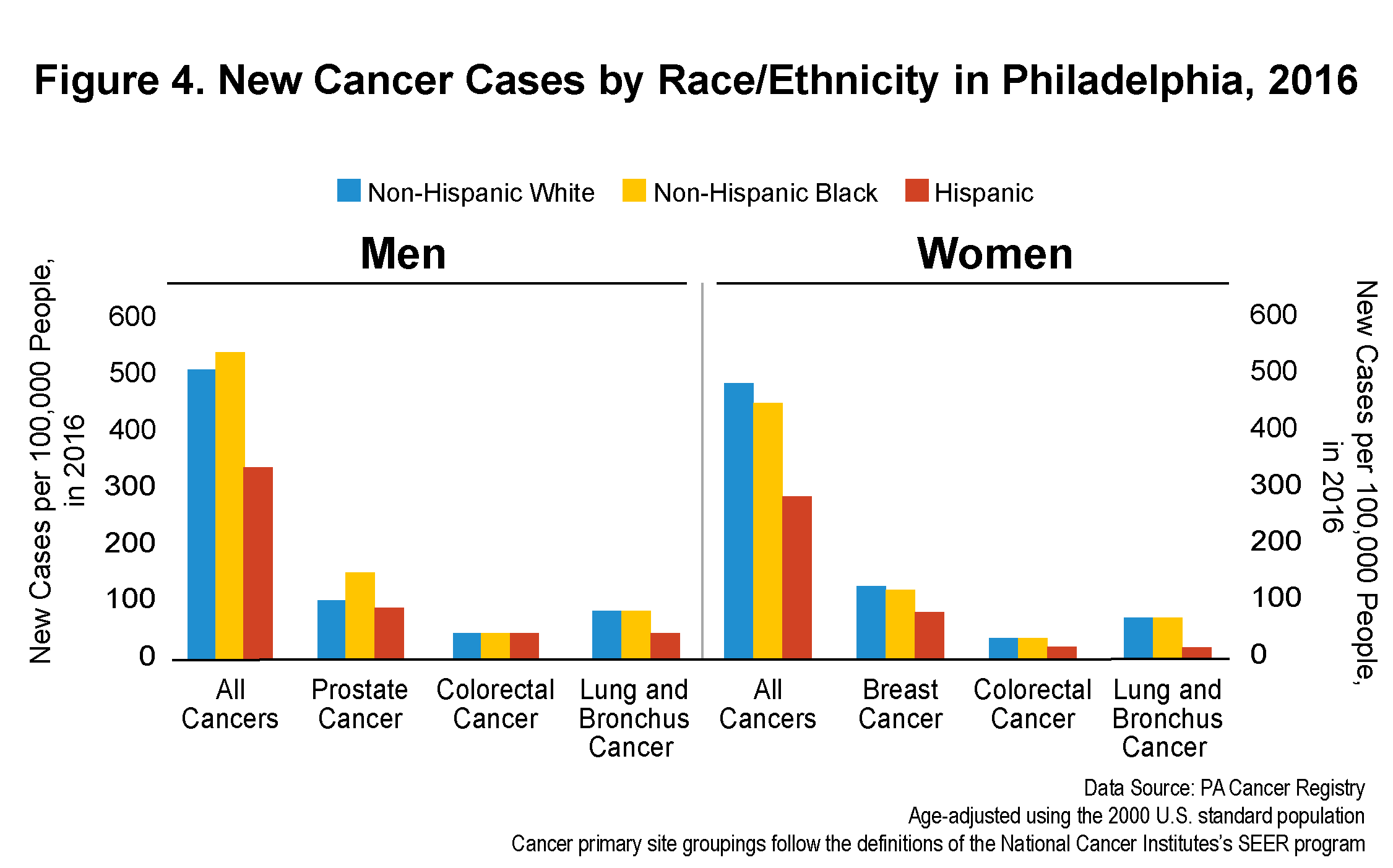
However, as seen in Figure 5 there are more cancer deaths among Black women compared to white or Hispanic women for most cancers, especially for breast cancer. Black men also have more cancer deaths due to most cancer types compared to white and Hispanic men, especially for prostate cancer.
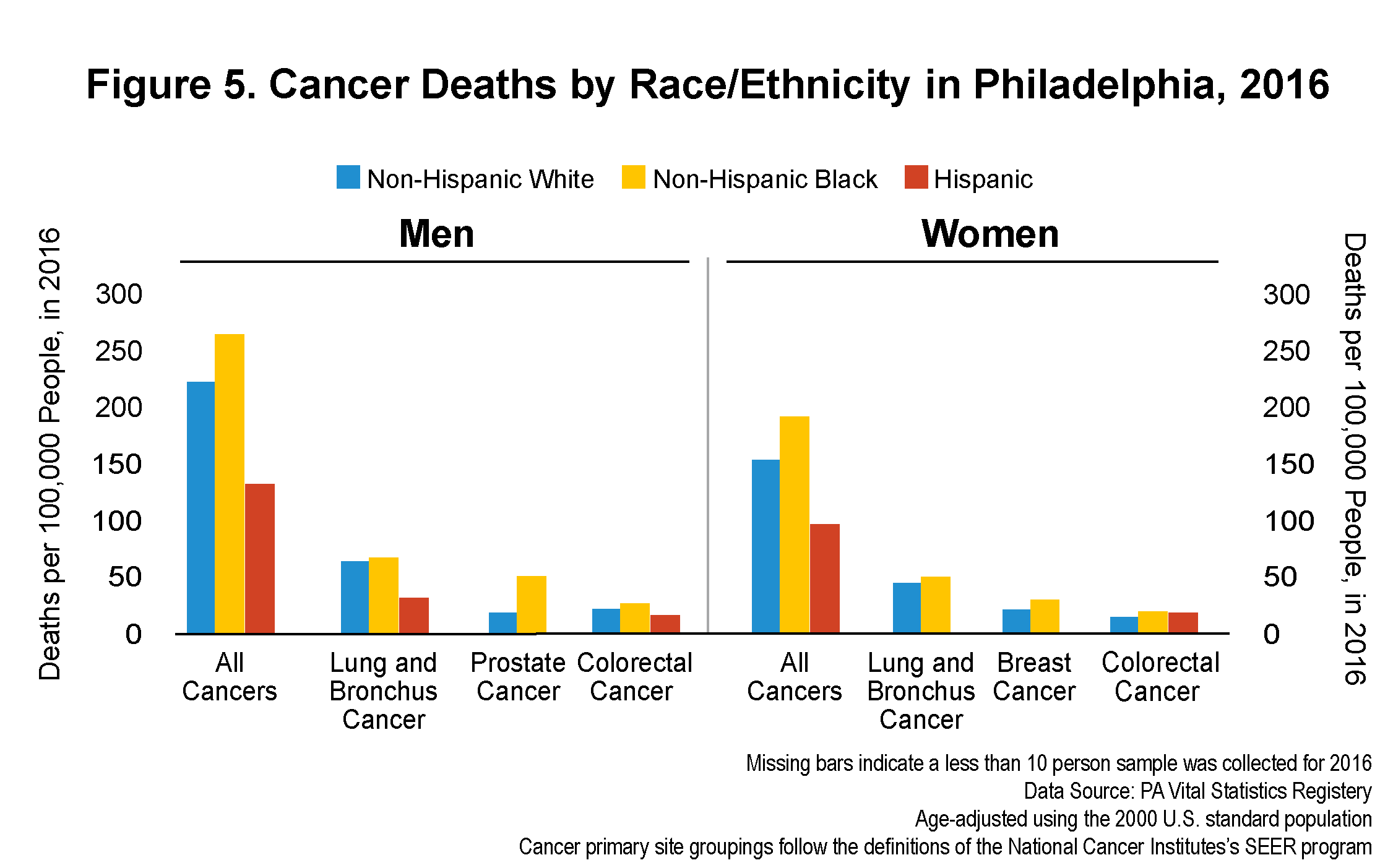
The higher cancer mortality rates in Black men and women may have to do with the types of cancer, the time of diagnosis (when cancer is diagnosed earlier outcomes can be better), or treatments received.
How does cancer vary by income?
As shown in Figure 6, new cases of cancer are more common among people from lower income neighborhoods than among people from higher income neighborhoods. Differences in cancer incidence by income may be due to differences in risk factors like smoking, diet or exercise.4 In some cases risks in the environment like indoor or outdoor air pollution could also play a role.5

As shown in Figure 7, cancer deaths are also more frequent in lower income neighborhoods than in higher income neighborhoods. Socioeconomic factors (like income) likely play a role in the higher mortality rates observed in Black residents.6
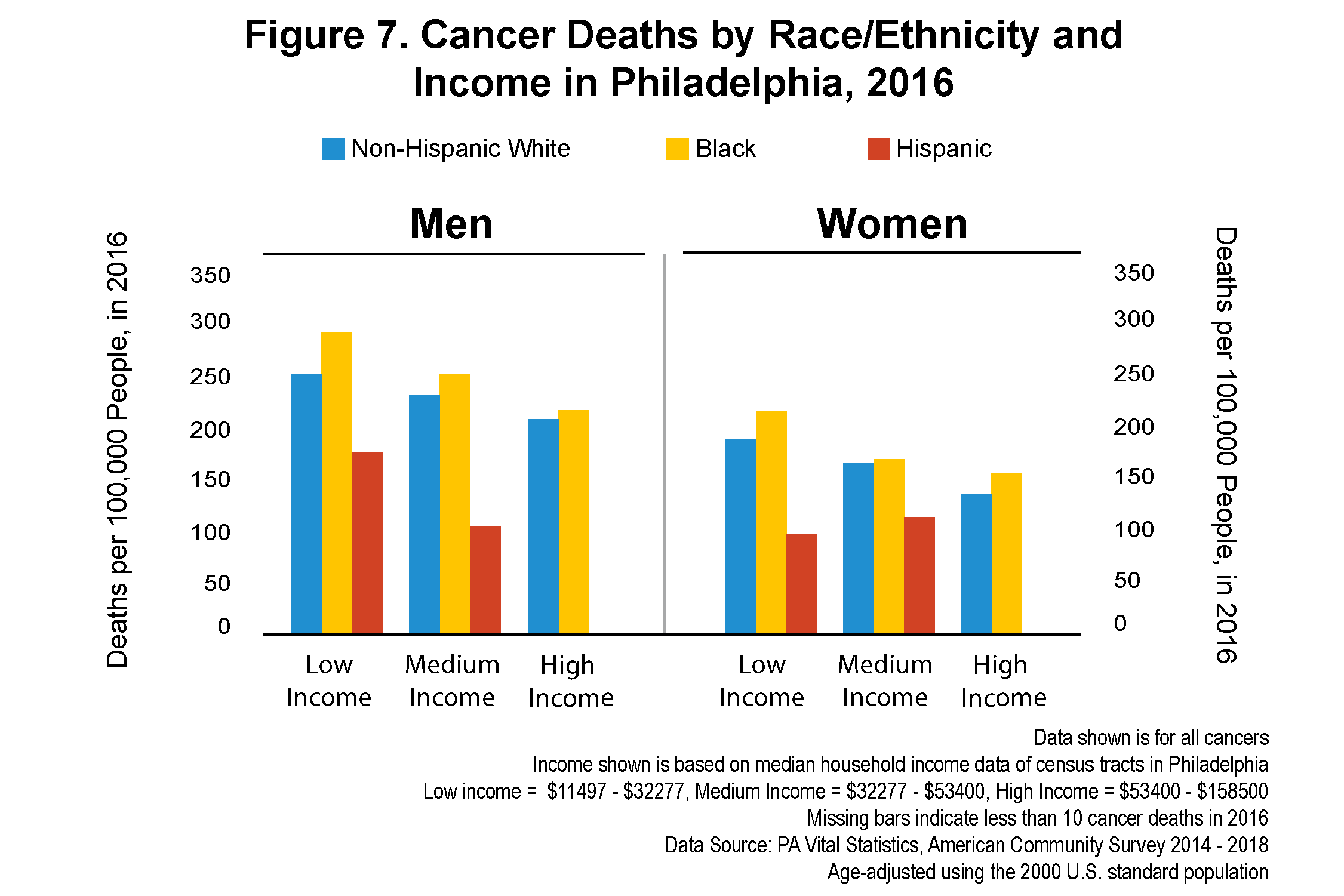
How this brief can be a resource to your community
A community brief uses existing data and information to describe health in a community. The purpose of this brief is to provide information on cancer in Philadelphia to residents and community organizations. The information can be used to support conversations about cancer and inform individual and community action.
What can communities do to prevent cancer?
There are things people and communities can do to prevent cancer. The box below shows the most important prevention tips. Some risk factors for cancer are well known and include smoking, secondhand smoke and binge drinking. Stopping smoking, being around other people who smoke and reducing excessive alcohol intake are among the most important things people can do to prevent cancer.7,8
Excessive weight (obesity), lack of physical activity and some dietary factors (low intake of fruits and vegetables and low intake of whole grains), may also be linked to cancer.9 Maintaining a healthy weight and eating a healthy diet with a lot of fresh fruits and vegetables and whole grains may help prevent cancer and other chronic diseases.10
Some specific cancers are related to risks in the environment. Although most cases of lung cancer are due to smoking, secondhand smoke and radon, a radioactive gas in the home can also increase risk for lung cancer.11 Working to reduce these exposures is therefore also important.
Prevention Tips:
There are steps that you can take to improve your overall health and reduce your risk of cancer9:
- Quit smoking and avoid being around other people who are smoking
- Advocate for safe, smoke-free outdoor spaces within your community
- Get your home tested for radon, a radioactive gas11
- Try to be physically active every day
- Limit or reduce drinking alcohol
- Limit the red meat and processed meat that you eat and increase fresh fruits and vegetables5
- Talk to your doctor about your health and your family’s health history
- Ask your doctor about getting screened for cancer:
- Women without a family history of breast cancer should start mammogram screening between
ages 45 and 50.12,13
- Men and women without a family history of colon cancer should start screening for colorectal
cancer (like a colonoscopy or stool test) between ages 45 and 50.
- African Americans should consider starting colon cancer screening by age 45.12,14
- If you have a family history of cancer, talk to your doctor about whether you need earlier
screening.
Resources for Philadelphia:
Smoke Free Philly smokefreephilly.org or call 1-800-QUIT-NOW
Food Fit Philly foodfitphilly.org
Philly Powered phillypowered.org
What can communities do to prevent cancer deaths?
When diagnosed with cancer, access to quality care and treatment can improve cancer survival. Early diagnosis through screening will help provide treatment at an early stage when it can be most effective. Yet many people are not getting the screening they need. A colonoscopy is a screening test that can be used to check for colon cancer. Figure 6 shows the percent of men and women who reported receiving a colonoscopy and the percent of women who reported receiving a mammogram screening test for breast cancer. More people in Philadelphia could be screened for colon cancer, particularly men.
What is the source of this information?
This brief uses information about cancer in Philadelphia for 2016 from the Pennsylvania Department of Health Cancer Registry and the Vital Statistics Registry supplied by the Bureau of Health Statistics & Registries, Pennsylvania Department of Health which collects and stores information about cancer cases and deaths in the State. The Pennsylvania Department of Health specifically disclaims responsibility for any analyses, interpretations, or conclusions. Information about mammogram and colonoscopy screening comes from the 2018 Southeastern Pennsylvania Household Health Survey developed by the Public Health Management Corporation.15 This brief was developed in collaboration with the Philadelphia Department of Public Health.
CITATION
Livengood K, Diez Roux A, Mullin G, Acharya B, Bettigole C, Moore K, Rollins H, Washington R. Community Brief: Cancer in Philadelphia. Drexel University Urban Health Collaborative; March 2020.
References
- Bureau of Health Statistics & Registries of the Pennsylvania Department of Health. Pennsylvania Cancer Registry. Accessed June 2019.
- Bureau of Health Statistics & Registries of the Pennsylvania Department of Health. Vital Statistics Registry. Accessed March 2018.
- O’Keeffe LM, Taylor G, Huxley RR, Mitchell P, Woodward M, Peters SAE. Smoking as a risk factor for lung cancer in women and men: a systematic review and meta-analysis. BMJ Open. 2018;8(10).
- Centers for Disease Control and Prevention. Health Disparities in Cancer. https://www.cdc.gov/cancer/healthdisparities/basic_info/challenges.htm. Accessed January 23, 2020.
- American Cancer Society. ACS Guidelines for Nutrition and Physical Activity. 2017; https://www.cancer.org/healthy/eat-healthy-get-active/acs-guidelines-nutrition-physical-activity-cancer-prevention/guidelines.html. Accessed February 4, 2020.
- American Cancer Society. Known and Probable Human Carcinogens. 2019; https://www.cancer.org/cancer/cancer-causes/general-info/known-and-probable-human-carcinogens.html. Accessed January 10, 2020.
- Centers for Disease Control and Prevention. Smoking and Cancer. https://www.cdc.gov/tobacco/campaign/tips/diseases/cancer.html. Accessed January 23, 2020.
- Centers for Disease Control and Prevention. Alcohol and Cancer. https://www.cdc.gov/cancer/alcohol/index.htm. Accessed January 23, 2020.
- American Cancer Society. Staying Healthy: Homepage. https://www.cancer.org/healthy.html. Accessed January 12, 2020.
- World Cancer Research Fund/American Institute for Cancer Research. Eat wholegrains, vegetables, fruit & beans. 2017; https://www.wcrf.org/dietandcancer/recommendations/wholegrains-veg-fruit-beans. Accessed January 10, 2020.
- Centers for Disease Control and Prevention. Protect Yourself and Your Family from Radon. 2020; https://www.cdc.gov/features/protect-home-radon/index.html. Accessed January 30, 2020.
- American Cancer Society. American Cancer Society Prevention and Early Detection Guidelines. https://www.cancer.org/health-care-professionals/american-cancer-society-prevention-early-detection-guidelines.html. Accessed October 14, 2019.
- U.S. Preventive Services Task Force. Breast Cancer: Screening. 2016; https://www.uspreventiveservicestaskforce.org/Page/Document/UpdateSummaryFinal/breast-cancer-screening1. Accessed January 30, 2020.
- U.S. Preventive Services Task Force. Colorectal Cancer: Screening. 2016; https://www.uspreventiveservicestaskforce.org/Page/Document/UpdateSummaryFinal/colorectal-cancer-screening2. Accessed January 30, 2020.
- Public Health Management Corporation. Public Health Management Corporation Community Health Data Base's Southeastern Pennsylvania Household Health Survey. 2018; http://www.chdbdata.org/. Accessed 01 September 2019.